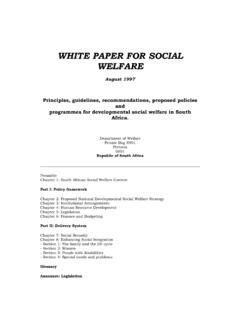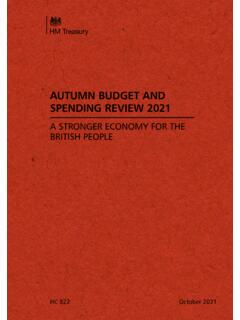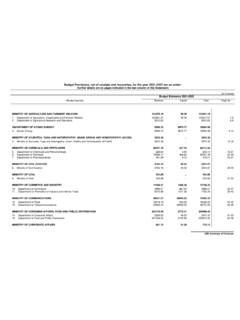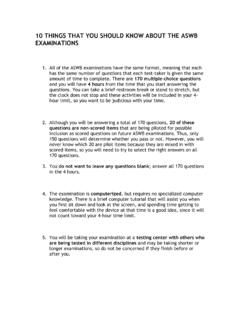Transcription of The Impact of Government Spending on Economic Growth
1 The Impact of Government Spending on Economic Growth by Daniel J. Mitchell, Backgrounder #1831 For more information, see the supplemental appendix to this paper. Policymakers are divided as to whether Government expansion helps or hinders Economic Growth . Advocates of bigger Government argue that Government programs provide valuable public goods such as education and infrastructure. They also claim that increases in Government Spending can bolster Economic Growth by putting money into people s pockets. Proponents of smaller Government have the opposite view. They explain that Government is too big and that higher Spending undermines Economic Growth by transferring additional resources from the productive sector of the economy to Government , which uses them less efficiently.
2 They also warn that an expanding public sector complicates efforts to implement pro- Growth policies such as fundamental tax reform and personal retirement accounts because critics can use the existence of budget deficits as a reason to oppose policies that would strengthen the economy. Which side is right? This paper evaluates the Impact of Government Spending on Economic performance. It discusses the theoretical arguments, reviews the international evidence, highlights the latest academic research, cites examples of countries that have significantly reduced Government Spending as a share of national Economic output, and analyzes the Economic consequences of those The online supplement to this paper contains a comprehensive list of research and key findings.
3 This paper concludes that a large and growing Government is not con-ducive to better Economic performance. Indeed, reducing the size of Government would lead to higher incomes and improve America s com-petitiveness. There are also philosophical reasons to support smaller Government , but this paper does not address that aspect of the debate. Instead, it reports on and relies upon Economic theory and empirical research.[1] The Theory: Economics of Government Spending Economic theory does not automatically generate strong conclusions about the Impact of Government outlays on Economic performance. Indeed, almost every economist would agree that there are circumstances in which lower levels of Government Spending would enhance Economic Growth and other circumstances in which higher levels of Government Spending would be desirable.
4 If Government Spending is zero, presumably there will be very little Economic Growth because enforcing contracts, protecting property, and developing an infrastructure would be very difficult if there were no Government at all. In other words, some Government Spending is necessary for the successful operation of the rule of law. Figure 1 illustrates this point. Economic activity is very low or nonexistent in the absence of Government , but it jumps dramatically as core functions of Government are financed. This does not mean that gov-ernment costs nothing, but that the benefits outweigh the costs. Costs vs. Benefits. Economists will generally agree that Government Spending becomes a burden at some point, either because Government becomes too large or because outlays are misallocated.
5 In such cases, the cost of Government exceeds the benefit. The downward sloping portion of the curve in Figure 1 can exist for a number of reasons, including: The extraction cost. Government Spending requires costly financing choices. The federal Government cannot spend money without first taking that money from someone. All of the options used to finance Government Spending have adverse consequences. Taxes discourage productive behavior, particularly in the current tax system, which imposes high tax rates on work, saving, investment, and other forms of productive behavior. Borrowing consumes capital that otherwise would be available for private investment and, in extreme cases, may lead to higher interest rates. Inflation debases a nation s currency, causing widespread Economic distortion.
6 The displacement cost. Government Spending displaces private-sector activity. Every dollar that the Government spends necessarily means one less dollar in the productive sector of the economy. This dampens Growth since Economic forces guide the allocation of resources in the private sector, whereas political forces dominate when politicians and bureaucrats decide how money is spent. Some Government Spending , such as maintaining a well-functioning legal system, can have a high rate-of-return. In general, however, governments do not use resources efficiently, resulting in less Economic output. The negative multiplier cost. Government Spending finances harmful intervention. Por-tions of the federal budget are used to finance activities that generate a distinctly negative effect on Economic activity.
7 For instance, many regulatory agencies have comparatively small budgets, but they impose large costs on the economy s productive sector. Outlays for international organizations are another good example. The direct expense to taxpayers of membership in organizations such as the International Monetary Fund (IMF) and Organisation for Economic Co-operation and Development (OECD) is often trivial compared to the Economic damage resulting from the anti- Growth policies advocated by these multinational bureaucracies. The behavioral subsidy cost. Government Spending encourages destructive choices. Many Government programs subsidize economically undesirable decisions. welfare programs encourage people to choose leisure over work. Unemployment insurance programs provide an incentive to remain unemployed.
8 Flood insurance programs encourage construction in flood plains. These are all examples of Government programs that reduce Economic Growth and diminish national output because they promote misallocation or underutilization of resources. The behavioral penalty cost. Government Spending discourages productive choices. Government programs often discourage economically desirable decisions. Saving is important to help provide capital for new investment, yet the incentive to save has been undermined by Government programs that subsidize retirement, housing, and education. Why should a person set aside income if Government programs finance these big-ticket expenses? Other Government Spending programs Medicaid is a good example gener-ate a negative Economic Impact because of eligibility rules that encourage individuals to depress their incomes artificially and misallocate their wealth.
9 The market distortion cost. Government Spending distorts resource allocation. Buyers and sellers in competitive markets determine prices in a process that ensures the most efficient allocation of resources, but some Government programs interfere with competitive markets. In both health care and education, Government subsidies to reduce out-of-pocket expenses have created a third-party payer problem. When individuals use other people s money, they become less concerned about price. This undermines the critical role of competitive markets, causing significant inefficiency in sectors such as health care and education. Government programs also lead to resource misallocation because individuals, organizations, and companies spend time, energy, and money seeking either to obtain special Government favors or to minimize their share of the cost of Government .
10 The inefficiency cost. Government Spending is a less effective way to deliver services. Government directly provides many services and activities such as education, airports, and postal operations. However, there is evidence that the private sector could provide these important services at a higher quality and lower cost. In some cases, such as airports and postal services, the improvement would take place because of privatization. In other cases, such as education, the Economic benefits would accrue by shifting to a model based on competition and choice. The stagnation cost. Government Spending inhibits innovation. Because of competition and the desire to increase income and wealth, individuals and entities in the private sector constantly search for new options and opportunities.






